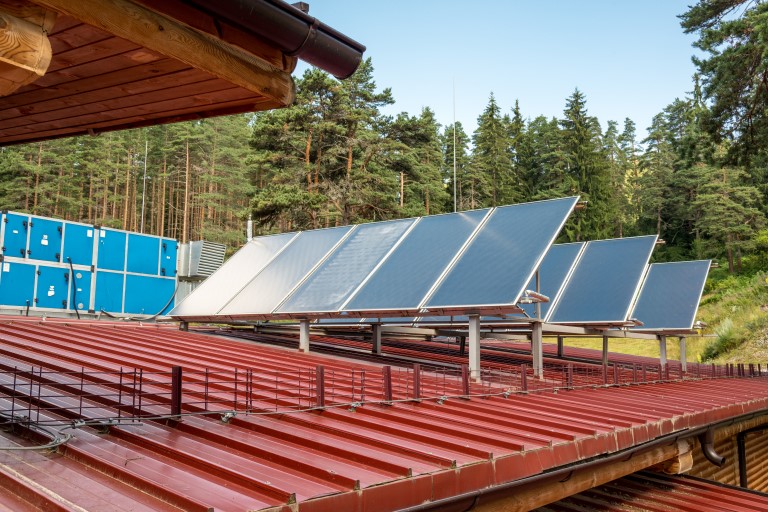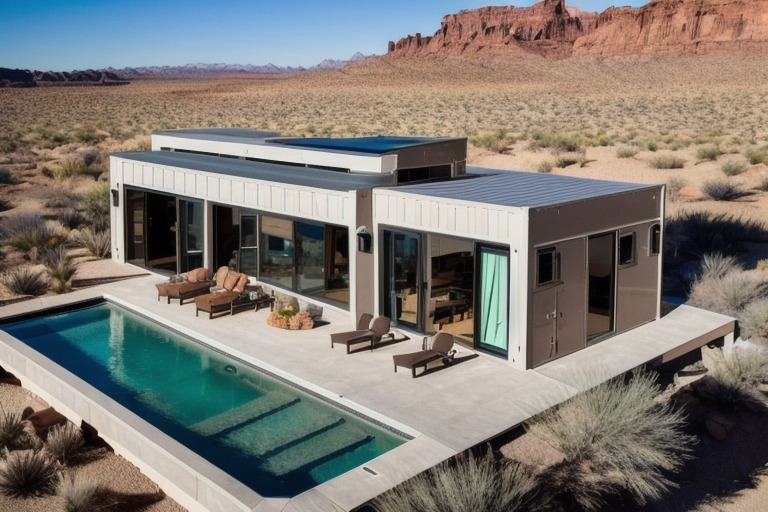That a shipping container is a metal box shouldn’t deter you from designing and building a container home in a hot environment – many people, have done this very successfully! We will look at some ideas that work, and some that don’t in this piece. They include using your garden to shade you, as well as passive air conditioning systems that will waft cool breezes through your home with minimal energy expenditure.
Ecotech Home, Mojave Desert
The 20ft solar breezeway. Image source: Inhabitat
Architects Ecotech built a shipping container home in the Mojave Desert near Joshua Tree in California (see top photo). This stand out piece of architecture was built of five, 20ft long modified shipping containers.
Being steel boxes, shipping containers can be ovens in the heat of the sun and don’t keep the heat in when it gets cold. California has some of the toughest building energy efficiency regulations in the US and as a result, the architects had to build in a number of energy efficiency aspects to the home.
- Insulation. This was one of the most important parts of the project. When one thinks of insulation one imagines a home built for a cold climate, but it works both ways – insulation is about creating an even temperature round the clock and round the year. It slows the ingress of heat or cold from outside, and prevents it from escaping. The Ecotech home used three layers of insulation, similar to that used in buildings in very cold climates, and this has been very effective in keeping the heat out.
- Cool roof. Ecotech incorporated a green roof into the design. Succulent plants suitable for the area live on a spongy, wet material where they draw their nutrients. The plants prevent the water from evaporating too quickly, but the water that does evaporate cools the roof down. When you sweat, your body is letting water evaporate from your body to do exactly the same thing, drawing the heat from your body as it does so.
- Solar shading system. This building uses a system of blinds above the living areas that form a shadow over it. In the same way as you would find a tree to sit under when it gets too hot, the idea is to reflect and absorb the heat before it reaches the green roof and into the home. Ecotech estimate that this reduces the solar heating of the home by more than 50%. At home, you may pull the curtains in the heat of the day for a similar reason – this prevents solar rays from getting in and cools the home as a result.
- Solar breezeway. The solar shading system covers an enclosed outside yard as well, and this creates a gentle wind that passes at ground level through the outside of the home. This is not unlike the idea of a sea breeze that makes life so much more comfortable on the beach on a blazing hot summer’s day.
- Active air conditioning. As many people in hotter areas of the world do, the home has an active air conditioning system. With a plain steel box, with none of the other passive heat mitigation systems in place, this would be burning through $$$ every five minutes! However the passive systems described above reduce the need for air-con considerably, and as a result the home is estimated to be 50% more energy efficient than the San Bernardino building regulations require.
Other ideas for keeping your desert home cool – passive cooling systems
Like it or not, energy prices are only going up in the foreseeable future. With that in mind, having very powerful electric air conditioning will burn through your cash – and honestly there are better things to spend your money on than a loud and powerful air con system! Here are three examples of how you can passively cool your home without paying the electricity company too much of your hard earned cash…
1. Trees!
.jpg)
One of the best forms of passive air conditioning is to have your home under shade. Mankind has sat under trees in the heat since the dawn of our evolution. The Arizona Solar Centre explain the technical benefits: “Mitigation of undesirable summer direct sun and thermal impacts is achieved through use of vegetation i.e. deciduous trees which interrupt the summer sun’s direct path, and ground covers which prevent ground reflection as well as keep the earth’s surface cooler thereby preventing re-radiation.”
In having shrubbery and plants on the ground, perhaps watered through your grey water recycling system, the ground radiates less heat and this in turn will keep the air around your home cooler.
2. Ducting systems
Since warm air rises, consider having air vents at the highest point of the home. The Arizona Solar Centre again: “Since warm air rises, vents located at high points in the interior will allow warm air to escape while cooler outdoor air flows in through low vents to replace it. The coolest air around a house is usually found on the north side, especially if this area is well shaded by trees or shrubs and has water features. Cool air intake vents are best located as low as possible on the north side. The greater the height difference between the low and high vents, the faster the flow of natural convection and the more heat mitigation can occur.”
In the Southern Hemisphere the sun comes from the north, so you would obviously consider the in-vents to be on the south side away from the sun and the out-vents on the north side.
A low energy air pump can be used through the ducting systems to encourage air flow, and since all it is doing is helping the laws of physics move air through your home, this will cost far less than an active air conditioning system that has to compress a coolant as well as pump air past it.
3. Grey water systems
Recycling water in areas with a hot climate is very important. If the water you used to brush your teeth with or had a shower in was re-used for your evaporative green roof, cooling garden or even your active air conditioning system, then it is being used extremely efficiently. In reusing water originally used for domestic purposes, for cooling the home then you are making maximum use of your resources.
Can you bury a shipping container?

One way to ensure that your shipping container home remains at a consistent temperature all year round might be to bury it. Looking around the internet, there have been attempts to bury them but few have actually worked out.
One expert in shipping container construction said outright, “Shipping containers have very little strength from the side. They have 0.07″ thick steel on the side which is about 2 mm thick (that is the metric system for you out there that remain convinced you can bury these things). That thin steel can take a bit of a beating from the random forklift hit, or someone hitting it with a hammer. However, the pressure of soil at 9 feet deep is about 315 lbs/sf. That’s a bit high for 2 mm of steel.” In short, you could well end up finding out what it is like to be in a beer can when someone crushes it with their fist!
The same expert looked at reinforcing the container in a concrete encasement when the question “Well, what if I encase it in concrete?” was put to him. By way of reply he says “Yes, that is an excellent idea. It will work. Here’s another idea – why not just make a concrete vault and save the hassle of the shipping container?” Shipping containers have a lot of positive things going for them but buried, they really aren’t that good an idea.

To get the benefits of the cooling earth you don’t need to fully bury your shipping container home. The partially buried home in the picture above is a prime example where people have only partially buried their home, allowing the earth to insulate it without crushing it. Unlike sticking a box 3 metres underground it has some architectural merit and won’t make your neighbours think you are preparing for the next apocalypse!
Solar energy
If you’re considering building a home where there is very little rainfall and a lot of sunshine then it makes an awful lot of sense to use the sun for your own energy needs. Solar photovoltaic (PV) cells can significantly drop your energy bills in a hot and sunny area. They are becoming very efficient as technology improves as well, and a lot of people are becoming completely energy independent in this way.
One of the problems associated with solar PV is that it only generates electric in the day, but green energy experts Tesla have recently invented a home battery that stores the excess electricity generated during the day for night time use. In places with hotter climates, the Tesla Powerwall can result in you needing to take no electricity from the power grid whatsoever. With your energy efficient desert shipping container home, this can make life in The Outback very cheap indeed!

Gateway Container Sales serves The Outback
As you can see, with a bit of thought and the right expertise to back you up, you can turn a metal box into a cool, cheap-to-run haven in the desert. If you have been thinking of setting up a energy efficient shipping container home in The Outback, then Gateway Container Sales & Hire can help. We have a network of experts who we can introduce you to, to develop your off-grid dream into reality. Get in touch with us today to discuss your needs or get a free quote!




